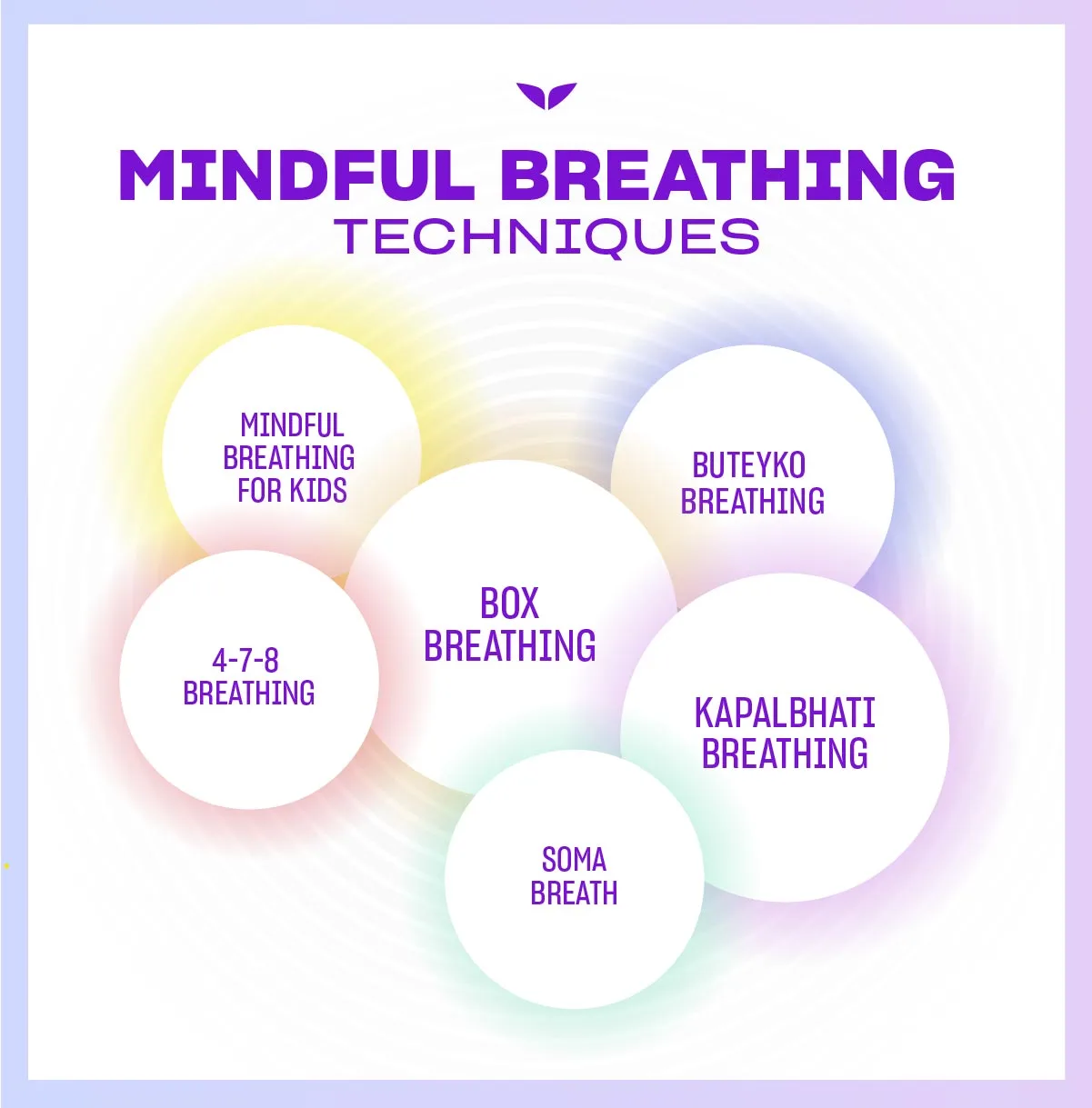You know those moments when your mind is racing, your heart’s pounding, and you can’t catch your breath? That’s stress as the norm for you. Yikes.
But high-pressure moments aren’t all there is to life, despite problems coming and going. What if the solution to these anxiety-ridden moments in between day-to-day tasks is simply… learning how to breathe better? Right in the thick of chaos?
We’re talking about mindful breathing, the age-old hack you didn’t know you needed that’s been anchoring spiritual practices for centuries.
But no need to get overwhelmed by the thought of complicated rituals or deep philosophical musings. Being mindful with your inhales and exhales really boils down to finding stillness in the havoc, powered by the inherent might of your lungs.
Now, let’s dive deeper into it.
What is mindful breathing?
Mindful breathing is the practice of bringing your full attention to each inhale and exhale.
Sounds simple, right? But boy, isn’t it a game-changer!
When it comes to breathwork, you’re essentially not just drawing in oxygen and exhaling carbon dioxide (CO²). Nope—you’re also actively tuning in to the rhythm of your entire breath cycles, making sure they’re steady and deliberate.
If breathing is akin to flying a plane, then think of mindful breathing as taking control of the steering wheel instead of flying on autopilot.
Scientifically speaking, this conscious deep breathing has some profound benefits: it effectively reduces anxiety, aids with stress, and even improves emotional regulation. When you’re paying attention to your breath, you’re telling your brain to chill out and take a step back from the panic mode we all slip into from time to time.
Niraj Naik, basically the breathing guru of the century and trainer of Mindvalley’s Breathwork for Life Quest, explains how this works in real-time: “When you slow down your breath, you can actually reverse the aging process. Animals like whales and elephants breathe slower and live longer. On the flip side, rats and mice breathe rapidly and live short, stressful lives.”
His point? The pace of your breathing affects way more than your stress levels—it can influence your longevity. So, if you’re here to live your best life, it starts with slowing down your breath.
You can also think of it like this: mindful breathing is your secret weapon for bringing balance back into your life. Train your lungs to follow a conscious rhythm, and you’re suddenly syncing your body, mind, and breath so that every part of you is working in harmony.
So, ready to breathe like an elephant and not a stressed-out rodent?
3 top powerful mindful breathing exercises
Here are some breathing exercises to help you level up your mindful breathing practice. Whether you need to focus, calm down, or just find your center, these exercises have you covered.
1. Coherent rhythmic breathing
Think of coherent, rhythmic breathing as your body’s natural momentum syncing with your breath.
It’s like when you finally find the perfect song in a new playlist, and everything just flows—right down to the tempo. Niraj says it’s the ultimate way to balance your nervous system. You inhale through your nose, let your belly expand, and exhale slowly. No rush, no panic—just steady breathing.
This kind of breathing is beneficial for moments when you feel out of sync with yourself, like when your mind’s going 100 miles per hour. Taking a few minutes to practice coherent breathing can reset your system, bringing calm and clarity.
2. Diaphragmatic breathing
This technique, also known as abdominal breathing, is especially useful for all you mouthbreathers out there. Breathing through your nose doesn’t just filter the air; it also naturally relaxes your body.
Niraj explains that nasal breathing increases nitric oxide production in your body, which helps calm your muscles, reduce inflammation, and even boost your mood.
“Nitric oxide is like your body’s internal healer,” he says. Breathing through your nose taps into that healing energy while keeping you calm and composed.
And here’s the kicker: when you breathe through your nose, you’re more likely to breathe deeply into your diaphragm. This motion stimulates your parasympathetic nervous system, which is responsible for chilling you out.
So, the next time you’re overwhelmed, try focusing on taking slow, deep breaths through your nose.
Need to foolproof the process to speed up your nasal breathing progress? Try mouth taping, a recent wellness hack many have touted as a game-changer.
3. Intermittent hypoxia
Holding your breath—which is what intermittent hypoxia is about—might sound counterintuitive, but it’s actually one of the most potent breathing exercises out there.
When you hold your breath, you’re building up carbon dioxide in your body. This might sound scary, but it’s actually a good thing. “CO² is what tells your body where to drop off oxygen. The more efficiently you can manage your CO², the better your body can use oxygen,” Niraj says.
This technique is all about training your body to be more efficient with its energy. The more you practice, the longer you’ll be able to hold your breath without feeling like you’re suffocating, and the more control you’ll have over your body’s response to stress.
5 mindful breathing techniques to try
Now that you have some breathing exercises under your belt, let’s explore more specific techniques that work in different situations. Whether you’re trying to keep your kids calm or get some quality sleep in for yourself, mindful breathing has your back.

1. Belly breathing for kids
Children have a lot going on these days, and it’s no wonder they get stressed out.
One of the easiest ways to help them manage their emotions is by teaching them mindful breathing for kids. A fun technique is belly breathing.
How to do it:
- Have them lie down.
- Place a toy on their stomach.
- Watch it rise and fall with their breath to observe their rhythm.
This exercise is simple, visual, and a great way to introduce mindfulness exercises and body awareness early on. Bonus: It helps them manage stress without them even realizing it.
For more ideas, check out these mindfulness activities for kids.
2. Kapalbhati breathing
If you’ve ever felt like your body’s hit a reset button after a serious spring cleaning, that’s what Kapalbhati breathing does for your insides. It’s a great detox tool for your brain and body.
How to do it:
- Start by sitting up straight.
- Then, exhale sharply and pull your stomach in like you’re squeezing out all the stress.
- Let your abdomen relax, and the inhale just happens naturally.
After 20 of these, you’ll feel like you just flushed out the day. Do two or three rounds.
With this technique, sleep also comes way easier. Speaking of sleep…
3. SOMA Breath technique
Tossing and turning? We’ve all been there. But instead of reaching for a sleep aid, try mindful breathing before bed.
Niraj suggests using his SOMA Breath technique to activate your body’s natural relaxation response and combat afflictions like anxiety. “In just a few minutes of slow, controlled breathing, you can bring your body back into balance and feel more relaxed and content,” he says.
How to do it (specifically for sleep):
- Inhale slowly through your nose for four seconds.
- Hold your breath for four seconds.
- Exhale through your mouth for six seconds.
- Repeat this cycle for 5 to 10 minutes.
In just a few minutes of slow, controlled breathing, you can lower your heart rate and prep your mind for deep, restful sleep. Give it a try the next time you find yourself stuck in that annoying “I can’t shut off my brain” loop.
4. 4-7-8 breathing
When you’re in full-blown stress mode at work, try 4-7-8 breathing. It’s magic for reigning you back into your body awareness.
How to do it:
- Breathe in through your nose for four seconds.
- Hold your breath for seven.
- Then, exhale for eight.
This exercise activates your parasympathetic nervous system and slows your heart rate almost immediately. It’s like pressing the emergency “calm down” button when you’re about to lose it.
5. Buteyko breathing
Buteyko breathing helps normalize your breath when panic strikes—through increased focus on nasal breathing, reduced airflow, and relaxation.
How to do it:
- Breathe through your nose for 30 seconds.
- Then, hold your breath briefly by closing your nose with your fingers before releasing it.
- Repeat the process as much as needed.
Doing this over and over again can help you regain control of your breathing and calm your system during moments of panic.
BONUS: Mindful breathing session
Here’s something extra to take your conscious breathing game to the next level: a meditation session led by Niraj himself, designed to boost your energy and awaken your mind.
Rooted in the SOMA Breath technique, this meditation is perfect for when you need to shake off the grogginess or get yourself back in the zone. It’s like having a jolt of clarity but without the crash.
Here’s how to do mindful breathing meditation:
Awaken your unstoppable
Mindful breathing isn’t just something you do. It’s something you control.
You’ve got the power to shift your mood, your energy, and your entire outlook just by tweaking how you breathe. From calming your nerves before bed to refocusing in the middle of chaos, mindful breathing is your all-access pass to a more balanced life.
If you’re ready to go deeper, the Breathwork for Life free class by Niraj Naik is what you can explore. Learn how to measure your hold time, correct your rhythm, and become your own health guru—all with the simple power of your breath.
You don’t need anything outside yourself to start healing. It’s all within you—one breath at a time.
Just look at Laris Nukić, a Bremen-based coach who improved his life with Niraj’s guidance:

“Before this quest, I was a ‘normal breather’ and just went through the day relatively normally. I was aware that through special breathing techniques, you can get a little more out of your life, and here I also tried various techniques—until I was allowed to experience and learn these techniques from Niraj Naik. WOW!”
Welcome in.









